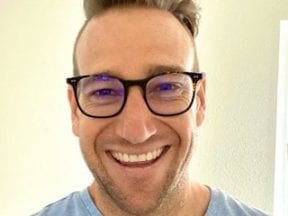Andrew Foxwell launched his digital marketing agency in 2012. The firm now manages social media advertising for brands worldwide. Having run countless campaigns amid nonstop change, Foxwell summarizes the key to a successful paid social marketer: a hunger to learn.
He and I recently spoke. I asked him about building a social media team, devising a strategy, and more.
The entire audio of our conversation is embedded below. The transcript is condensed and edited for clarity.
Eric Bandholz: Tell us what you do.
Andrew Foxwell: I own and operate a paid social agency in Wisconsin called Foxwell Digital. We also run a community of digital marketers, mainly agencies, called the Foxwell Founders. We have about 440 members from 25 countries spending an average of $200 million a month on Meta ads. We discuss conversion rate optimization, Google, TikTok, Pinterest, and agency running. I’ve been doing Facebook ads since they were invented.
Bandholz: Can you share some strategies for building a paid marketing team?
Foxwell: In my experience, someone good at paid social is both ambitious and green. A hunger to learn is critical — with a mix of analytical thinking, constant curiosity, and creative background. Every candidate is different. There are no best practices.
Part of being a successful employee is knowing where to set boundaries to throttle learning and to weave it in throughout the day. Adopting a learning mindset spills over into everywhere else, and fosters success.
Bandholz: What are the pillars of a social ad strategy?
Foxwell: From an agency standpoint, we start with understanding a client’s current funnel. What are they saying? What are they uniquely positioned to say, and where are they going? What’s the flow? Looking at all the parts holistically, from ads to email, will set you apart.
Many of us were brought up in a fairly myopic paid social era. An advertiser could launch campaigns to earn three more dollars, for example. We could track the return on ad spend on Meta.
It’s different now. We have to consider the entire funnel and understand consumer psychology. Not just trends but the types of content in your ad pipeline. Look at what Meta is pushing now. Then test it for your own campaigns.
An example is Meta’s Advantage+ shopping campaigns. They’ve changed ad credits to allow us to test those campaigns for free from Facebook Shops. That’s another framework to review and learn from others.
Meta campaigns are less about the micro audiences and timeframe windows than they used to be. It’s assessing the whole funnel, including the creative trends and how to build a feedback system.
A small agency might build a feedback system in a Google Sheet and enter information manually, noting, “We tested on this date, and this is what it looks like.” As the agency grows, that framework evolves to Notion and ClickUp documents. Steps have to be completed. Feedback must be recorded — summarizing what happened. And the creative and performance metrics become part of the process.
That’s what an effective system looks like, more or less. It’s constantly evolving for most of us. Ultimately, it’s better for the consumer because we’re not just putting out a photo of a product. It’s more meaningful.
Bandholz: Does paid social work for all companies?
Foxwell: A huge factor is product market fit. What are you doing that’s different from competitors? Again, there are no best practices. Certainly average order values are important. It’s hard to make paid social work in the U.S. or Canada if you have an AOV lower than $75. The cost per thousand impressions will likely range from $35 to $200 or more. Depending on the product and niche, your ad might not even show for a thousand impressions.
An advertiser’s brand is less important initially — more so for loyalty. The recipe depends on where you’re at and your niche. Take women’s skincare, for example. A high AOV, perhaps $200, is tough to get prospects to convert owing to the competition. Testing it on Meta could run upwards of $20,000 a month, which means long-term retention to earn back that acquisition cost.
Bandholz: Creating affordable content is a challenge for many brands.
Foxwell: Retaining creative freelancers can be cost-effective. We see it frequently, wherein a merchant or agency gives direction to the freelancers. That might be a couple of individuals taking photos and videos. They’re getting guidance and scripting.
For example, we offer a video or photo “shoot list” template in our membership community. It’s one of the most requested documents. It provides direction to freelancers. You’re paying for their time and need to be as efficient as possible.
Bandholz: Where can people support you?
Foxwell: FoxwellDigital.com is where everything is at. Our community membership link is there, as are our courses. I’m on Twitter, too.




